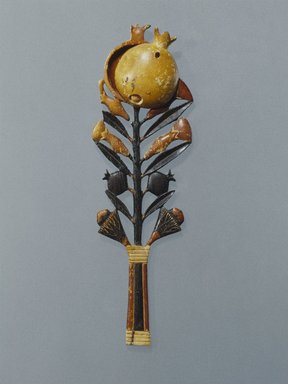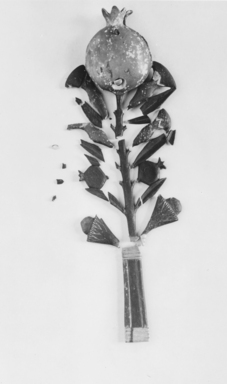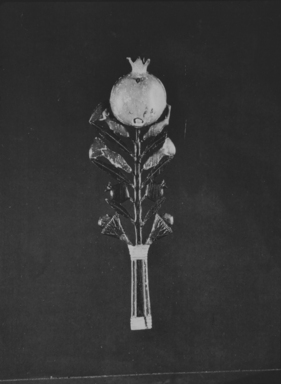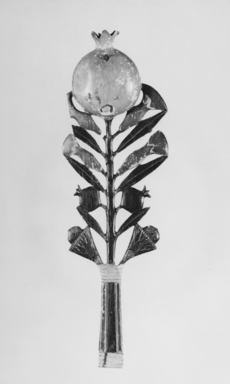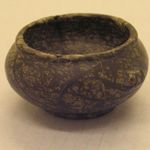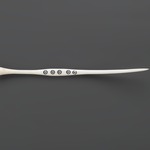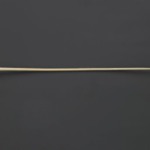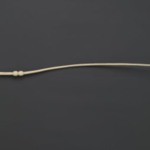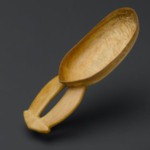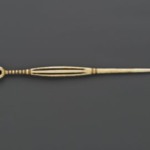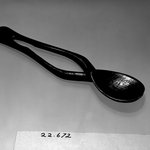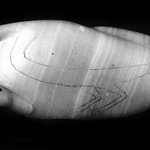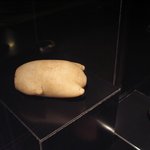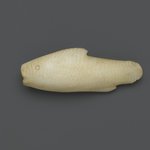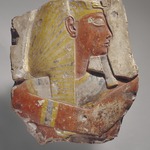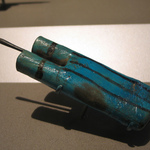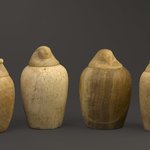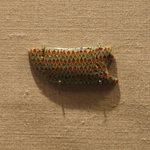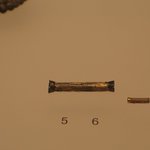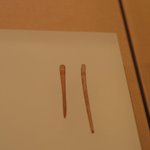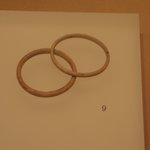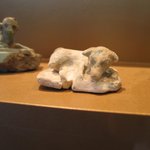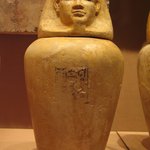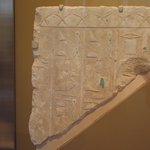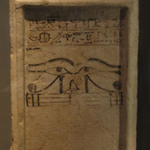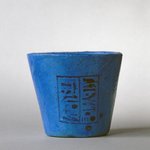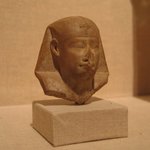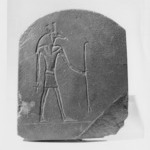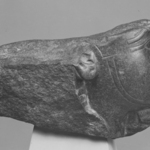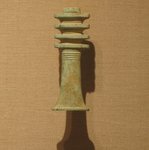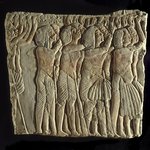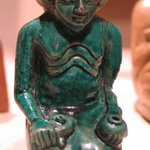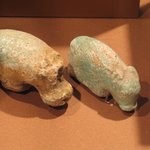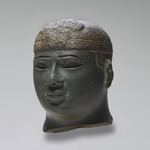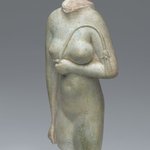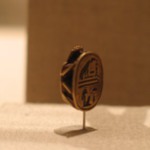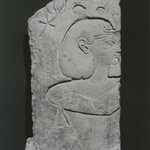Spoon
Egyptian, Classical, Ancient Near Eastern Art
On View: 19th Dynasty to Roman Period, Martha A. and Robert S. Rubin Gallery, 3rd Floor
The late Eighteenth Dynasty was one of the the most flamboyant and excessive periods of design in Egyptian history. This spoon demonstrates the dominant aesthetic of the day: the complementary union of naturalistic elements, formal design, and excessive, stylized detailing.
The motif is a pomegranate branch terminating in a huge reddish-yellow fruit that swivels on a tiny pivot to reveal the bowl of the spoon. Tiny pomegranates,
brightly painted flowers, and slender leaves project from the stem that serves as the handle. Beneath the lowest leaves the artisan has added an extraordinary embellishment: two lotus flowers, each with a
Mimispos fruit emerging from it.
Although the individual elements of the spoon are treated with painstaking attention to detail, the design
itself is pure fantasy. For example, pomegranate flowers and fruit never appear on a tree at the same time.
MEDIUM
Ivory
DATES
ca. 1336–1327 B.C.E.
DYNASTY
late Dynasty 18
PERIOD
New Kingdom
DIMENSIONS
2 9/16 x 11/16 x 8 3/16 in. (6.5 x 1.8 x 20.8 cm)
(show scale)
ACCESSION NUMBER
42.411
CREDIT LINE
Charles Edwin Wilbour Fund
CATALOGUE DESCRIPTION
Polychromed ivory ointment-spoon in the shape of a pomegranate, with a stem bearing flowers and small pomegranates forming the handle. The pomegranate forming the bowl of the spoon is in two sections, the upper one serves as a cover. It opens on a swivel pin; part of a small knob (?) used for turning it still survives. The stem, bearing two pairs of flowers, three pairs of lanceolate leaves and a pair of small pomegranates, has, at the base two half-opened lotus flowers on long stems which are represented as being bound by withes to the pomegranate stem to form the manche of the handle. The large pomegranate forming bowl of the spoon is painted in a warm, pale brown, the flowers are deep red, the leaves, stem and small fruits black, the withes at the handle pale brown and the lotus stems red. Save that the underside of the large pomegranate is somewhat flattened to provide a surface on which to rest the spoon, the piece is identical on the two sides. Probably made for funerary purposes, not for actual use.
CAPTION
Spoon, ca. 1336–1327 B.C.E. Ivory, 2 9/16 x 11/16 x 8 3/16 in. (6.5 x 1.8 x 20.8 cm). Brooklyn Museum, Charles Edwin Wilbour Fund, 42.411. Creative Commons-BY (Photo: Brooklyn Museum, 42.411_SL1.jpg)
IMAGE
overall, 42.411_SL1.jpg. Brooklyn Museum photograph
"CUR" at the beginning of an image file name means that the image was created by a curatorial staff member. These study images may be digital point-and-shoot photographs, when we don\'t yet have high-quality studio photography, or they may be scans of older negatives, slides, or photographic prints, providing historical documentation of the object.
RIGHTS STATEMENT
Creative Commons-BY
You may download and use Brooklyn Museum images of this three-dimensional work in accordance with a
Creative Commons license. Fair use, as understood under the United States Copyright Act, may also apply.
Please include caption information from this page and credit the Brooklyn Museum. If you need a high resolution file, please fill out our online
application form (charges apply).
For further information about copyright, we recommend resources at the
United States Library of Congress,
Cornell University,
Copyright and Cultural Institutions: Guidelines for U.S. Libraries, Archives, and Museums, and
Copyright Watch.
For more information about the Museum's rights project, including how rights types are assigned, please see our
blog posts on copyright.
If you have any information regarding this work and rights to it, please contact
copyright@brooklynmuseum.org.
RECORD COMPLETENESS
Not every record you will find here is complete. More information is available for some works than for others, and some entries have been updated more recently. Records are frequently reviewed and revised, and
we welcome any additional information you might have.
The label says it is a spoon, but how would someone use it? Just remove the fruit shape lid?

This spoon actually held an ointment, so it is more a container with a spoon shape not so much a spoon used for eating. But, yes, the ointment would be accessed by taking off the lid. The huge reddish-yellow fruit swivels on a tiny pivot to reveal the bowl of the spoon.
How do you actually eat with this?
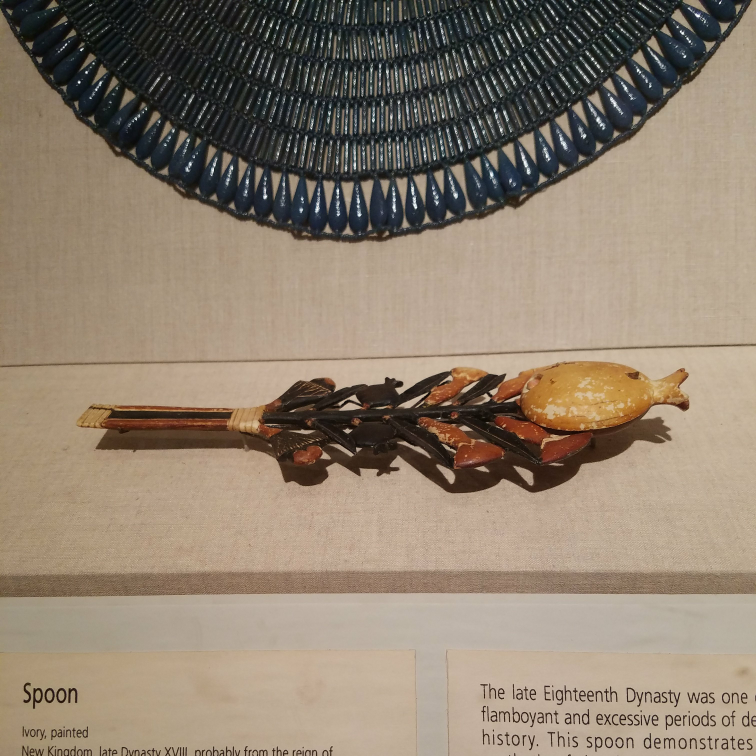
Though this object is indeed referred to as a spoon, it wasn't for eating with, it was designed to hold cosmetics like ointments or eye makeup.
The pomegranate (to the right in the photo) is on a hinge and can swing to the side to reveal the bowl of the "spoon."
What were the common ingredients for the cosmetics?
We don't know for certain and it varies from cosmetic to cosmetic but a popular cosmetic in ancient Egypt was kohl. It was applied like modern day eyeliner and was made of ground stibnite, a sulfide mineral. It was believed that darkening the skin around one's eyes protected from the glare of the sun.
Other cosmetics include the fragrant cone. You might see depiction of this in reliefs where women have a cone shaped mound on their head. This was made of fragrant oils and butters that would melt during the day, releasing a pleasant scent.
